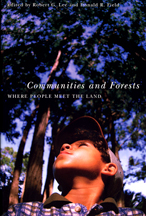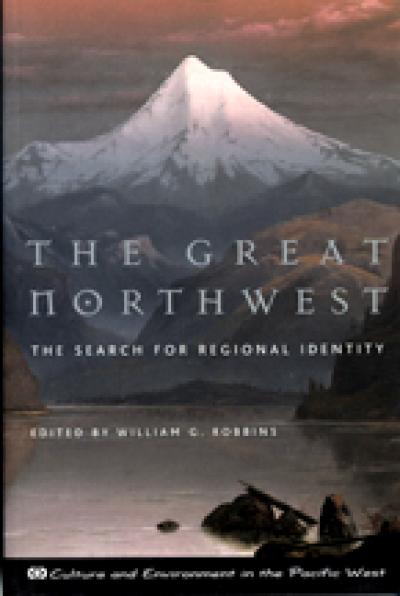
Communities and Forests
Robert G. Lee and Donald R. Field
Foreword by Hal Salwasser.
Communities and Forests offers a timely view of the changing face of forests and forestry in North America today. In examining interactions between people and forests, the book shows that forests are as much a social institution as they are a biological resource.
Editors Robert Lee and Donald Field document the shift from scientific forestry to community forestry. They note that the traditional science-based, state-controlled model for managing forests ignores the voices of those affected by the use of forest resources. The editors suggest that science-based forestry is giving way to an alternative approach, one in which nature, economy, society, and culture are considered integral elements of the human-forest relationship. They see a future where forestry will continue to be informed by science but shaped by community values.
Contributors to this volume consider the connection between forests and communities from a variety of perspectives, including environmental history, natural resource sociology, and forest policy. The book begins with an investigation of the historical and sociological foundations of community-based forest management. Chapters in the second section highlight the diverse issues surrounding community forestry, specifically the conflicts between the management of public forestlands and the interests of various stakeholders in using forests as a public good. The final section examines urban forestry, focusing on both the importance of forestry in urban settings and the demographic shifts that have brought people with urban values and lifestyles to rural, forested settings.
With its unique focus on the integration of communities into decision-making about forests, this collection of insightful essays will prove useful to public and private land managers, as well as to researchers and students in the fields of forestry, resource management, rural sociology, regional planning, environmental studies, and parks and recreation.
About the author
Robert G. Lee is Professor of Sociology of Natural Resources in the College of Forest Resources at the University of Washington.
Read more about this author
Donald R. Field is a Professor in the Departments of Rural Sociology and Forest Ecology and Management at the University of Wisconsin. He is co-editor of National Parks and Rural Development and On Interpretation: Sociology for Interpreters of Natural and Cultural History.
Read more about this author
Preface (Hal Salwasser) ............................................................. viii
Chapter 1. Introduction: From Scientific Forestry to
Community Forestry (Robert G. Lee and Donald R. Field) ............. 1
Section I: Sociological Foundations for Studying Community
and Forests ............................................................................... 15
Introduction to Section I: Continuities in the Sociology of
Natural Resources (Donald R. Field and Robert G. Lee) .............. 15
Chapter 2. Conditions for the Realization of Values Remote in
Time (Walter Firey) .................................................................... 18
Chapter 3. Rural Sociology and Natural Resources: Building on
Firey (Donald R. Field, A. E. Luloff, and Richard S. Krannich) ...... 31
Chapter 4. Resource Management as a Democratic Process:
Adaptive Management on Federal Lands (Nancy Langston) ......... 52
Chapter 5. Human Values and Forests: Changes in the Great Lakes
Wildlands (Samuel P. Hayes and Greg Clendenning) ................. 77
Chapter 6. Toward the Stabilization and Enrichment of a
Forest Community (Harold F. Kaufman and Lois C. Kaufman) .... 96
Section II: Diversity and Change in Forest-based
Communities .......................................................................... 113
Introduction to Section II: Diversity in Interactions between
Communities and Forests (Robert G. Lee and
Donald R. Field) ...................................................................... 113
Chapter 7. Power Plants and Forest Plans: Two Decades of
Mobilization in a Mountain Forest Community (Jonathan
London, Paul F. Starrs, and Louise Fortmann) ........................ 116
Chapter 8. Pulp, Paper, and Poverty: Forest-based Rural
Development in Alabama, 1950-2000 (John C. Bliss and
Conner Bailey) ....................................................................... 138
Chapter 9. Occupational Community and Forest Work:
Three Cases from the Pacific Northwest (Matthew S. Carroll,
Robert G. Lee, and Rebecca J. McLain) ................................... 159
Chapter 10. Communities and Forestry in Canada: A Review and
Analysis of the Model Forest and Community-Forest Programs
(Gary Bull and Olaf Schwab) ................................................... 176
Chapter 11. The National Community Forestry Center—An
Experiment in Institutionalizing Community Forestry in the
United States (Ajit K. Krishnaswamy) ...................................... 193
Chapter 12. Another Look at Private Forestlands: America’s
Forest Landowners (James C. Finley, A. E. Luloff, and
S. B. Jones) ............................................................................ 210
Section III: Community and the Urban Forest ..................... 225
Introduction to Section III: Demographic Cycles and the
Future of Urban and Exurban Forests (Donald R. Field and
Robert G. Lee) ........................................................................ 225
Chapter 13. Community Empowerment and the Urban Forest
(Maureen H. McDonough and Kerry E. Vachta) ....................... 228
Chapter 14. Social Mosaics and Urban Community Forestry in
Baltimore, Maryland (Morgan Grove, William R. Burch, Jr., and
S. T. A. Pickett) ....................................................................... 249
Chapter 15. Exurban Migration: Implications for Forest
Communities, Policies, and Practices (Andrew F. Egan and
A. E. Luloff) ............................................................................ 274
Section IV: Conclusions and Implications ........................... 291
Community Complexity: Postmodern Challenges to Forest and
Natural Resources Management (Robert G. Lee and
Donald R. Field) ..................................................................... 291
Contributors .......................................................................... 304
Index ..................................................................................... 306




